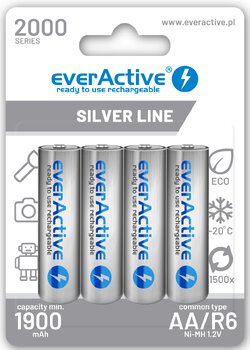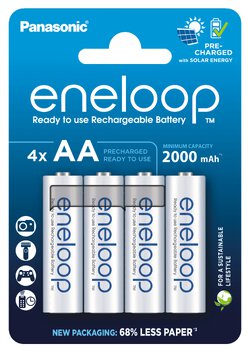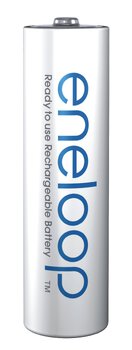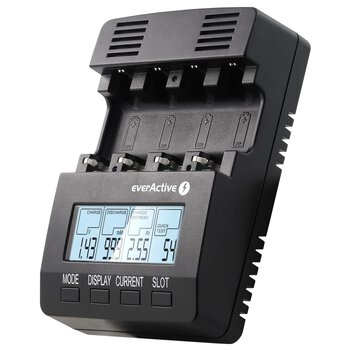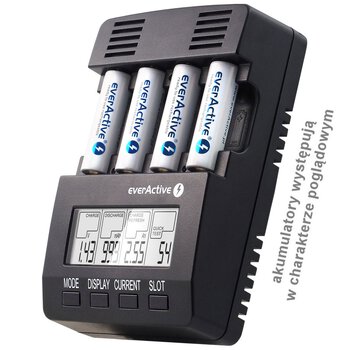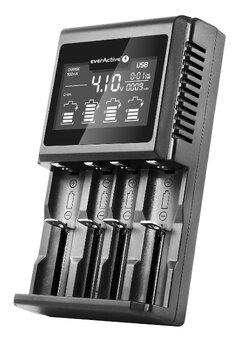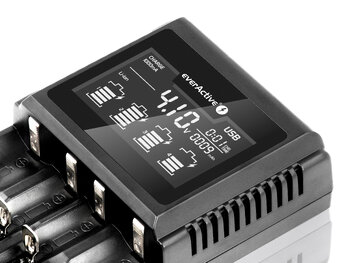- Tips
- technology
- Frequently Asked Questions
- Tests
- mAh capacity
- Rated Capacity
- everActive
- comparison
- Durability of rechargeable batteries
- Efficiency of rechargeable batteries
- battery voltage
- Accumulated energy
- Batteries vs rechargeable batteries
- LR03 AAA
- LR6 AA
- eneloop
- AG13 LR1154 LR44
- Delta V
- Charge Cycles
- internal resistance
- charge level
- CR 2032
- memory effect
- accredited test
- SR44 357
- Hearing Batteries 675
- SR626 377
- Watch Batteries
- Polarity
- Mah
- passivation
- LS 14250
- LS 14500
Is it worth discharging Ni-MH batteries before each charge?
To explain this topic in detail, it is necessary to go back in time when Ni-Cd cells were commonly used.
Many readers have probably come across such a term as the "memory effect" of the battery.
The memory effect, characteristic of older Ni-Cd batteries, resulted in a reduction in the usable capacity of the batteries. An example of a cell discharged regularly only in 25% "remembered" the moment when the battery was disconnected and recharged. During later use, the battery remembered the moment when it was disconnected and already being discharged in only 25% it showed signs of an empty cell (there was a clear voltage drop). In practice, it was difficult to use the 75% of the capacity still remaining in the battery.
We will write more about the memory effect and its relationship with newer Ni-MH batteries in the next article.

Fig.1 Discharge characteristics of a Ni-Cd battery.
A preventive method for this unwanted phenomenon was additional, forced discharge of such a battery to the voltage level of 0.9V, sometimes even lower. Many users recommended such discharge before each battery charge.
Currently produced Ni-MH batteries are not so prone to the memory effect. In their case, we sometimes talk about the lazy battery effect, which consists in an apparent increase in the internal resistance of the battery and a decrease in its efficiency. However, the nature of this change is much milder and is not as durable as in the case of Ni-Cd batteries.
Discharging Ni-MH batteries before each charge leads to their much faster wear.
An average Ni-MH battery, being regularly discharged in 50%, lasts about 4 times more charging cycles compared to one that is completely discharged each time (up to 1.0V). It's easy to calculate that the same battery can get a total of 100% more capacity over its life cycle.
An additional problem that reduces the life of Ni-MH batteries is the way in which the discharge mode is implemented in some popular chargers. Many of these chargers were designed for Ni-Cd batteries. In such chargers, the actual discharge voltage threshold may be too low for the Ni-MH battery, and the battery is automatically charged to full when the discharge mode is completed. Such a seemingly convenient to use discharge mode appealed to many users, so much so that batteries are still quite often "charged" in this way and, unfortunately, "killed" every time. An example of a poorly performed process of discharging a heavily used Ni-MH battery in a popular charger is shown in the chart below.
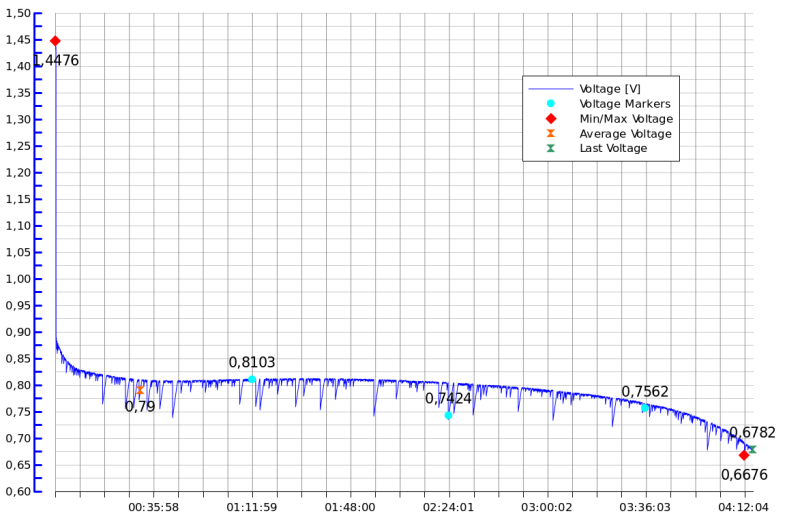
Fig.2 Discharge characteristics of a used Ni-MH battery in the Technoline BC-700 charger.
According to the specification, the charger is supposed to discharge the battery to 0.9V, while in practice the minimum discharge voltage in this case was clearly below 0.7V. The charger also misjudged the usable capacity of the battery in this case.
Such a low discharge threshold is too low for Ni-MH batteries and leads to even faster degradation of such a battery.
Of course, we encourage you to check the condition of your batteries. With the right charger, nothing stands in the way of discharging the battery for this purpose, measuring its capacity at the same time, etc. However, you absolutely should not abuse the discharge modes.
There is no point in forcing the Ni-MH battery to discharge more often than once every 5 charging cycles or more often than every six months - this is completely sufficient to track the degree of wear and tear of the batteries and keep them as good as possible.
Popular rechargeable batteries and chargers for Ni-MH batteries in the hurt.com.pl store:
4x everActive R6/AA Ni-MH 2000 mAh ready to use "Silver line"
4 x Panasonic Eneloop Ni-MH 2000mAh BK-3MCDE/4BE rechargeable batteries (blister)
New - improved MCDE series
Higher capacity min. 2000 mAh
New eco-friendly packaging for storing rechargeable batteries
- up to 2100 charging cycles
- retains 70% of energy after 10 years after charging!
- works at low temperatures down to -20°C. C!
- charged in the production process with solar energy
Made in Japan
Charger everActive NC-3000
Processor with discharge and measurement of capacitance and a unique test of internal resistanceof the cell,
function of refresh, maintenance, battery formation,
Min. Charging time 4 batteries 2500mAh-3h.
Processor, Ni-MH, Ni-Cd, 1-4x R6/AA, R03/AAA, 1-2x R14/C, R20/D using optional adapter
12V DC Input voltage-AC adaptor included, optional car adaptor available
2 years Warranty
Charger for Li-Ion and Ni-MH rechargeable cylindrical batteries everActive UC-4000
- professional, universal microprocessor charger for Li-ion cells, Li-FePO4, Ni-MH,
- discharge and refresh function to maximize battery life,
- unique function to measure and review two capacity values for each battery after single refresh cycle - Capacity Review,
- Supported sizes: R6 AA, R03 AAA, R14 C, R20 D, 10440, 14500, 14650, 17500, 17670, 18350, 18500, 18650, 20700, 21700, 22650, 25500, 26500, 26650, 32650, 33600, 16340 R-CR123e,
- Charging current: 500 mA, 1000 mA for Li-ion/Li-FePO4, 500 mA for Ni-MH,
- very accurate and precise charging scheme regardless of battery type.
Author: Michał Seredziński
Copying the content of the text or its part without the consent of a representative of Baltrade sp. z o.o. is prohibited.
-
Hmm... kiedyś BC-700 była uważana za jedną z pierwszych niezłych ładowarek mikroprocesorowych... A wychodzi na to, że psuła. Jaki model teraz jest uważany za "standard"? Na obecny stan wiedzy, oczywiście.
-
BC-700 nie była "złą" ładowarką jednak sprzyjała ona m.in. nadużywaniu trybu rozładowania, który niestety pomijał w dużym stopniu fakt istnienia rezystancji wewnętrznej danego akumulatorka. To w połączeniu ze zbyt niskim domyślnym prądem ładowania mogło w dłuższej perspektywie przyspieszać zużycie akumulatorków i powodować szybsze pogorszenie ich wydajności.
Efektem wtórnym były w tej ładowarce zbyt optymistyczne wyniki testów pojemności osiąganych nawet na wieloletnich akumulatorkach, które mogły być już mocno zawodne.
Ładowarką najbliższą funkcjonalnie do BC-700, jednak z naprawionymi błędami "logicznymi" jest model NC-1000 Plus marki everActive. Nieco uproszczonym i unowocześnionym wariantem jest z kolei NC-1000M.
-
-
Witam. Mam problem z akumulatorkami AAA eneloop 750mAh. Po półtora roku użytkowania, 3 szt. odmówiły współpracy. Na ładowarce NC-1000 plus wyświetla się komunikat "null". Akumulatory używane w zabawkach dziecka. Prawdopodobnie zostały zbyt mocno rozładowane. Czy jest sposób na ich "naprawę" ww. ładowarką, czy potrzeba czegoś bardziej zaawansowanego? Poproszę o pomoc, bo prawdopodobnie taki los będzie czekał więcej moich akumulatorów.
-
Model NC-1000 wykrywa akumulatorki dość "nisko" bo już od napięcia ok. 0,4V. Jednak zdarza się, że akumulatorek zostanie rozładowany do napięcia 0V, albo nawet zostanie przebiegunowany. W tym drugim wypadku większość zaawansowanych ładowarek odmówi ładowania takiego akumulatorka.
Można jednak z tym problemem sobie poradzić - opisujemy to w innym wpisie: https://www.hurt.com.pl/blog/fakty-i-mity-o-ladowaniu-akumulatorkow-ni-mh-porady-dla-uzytkownikow-akumulatorkow-ni-mh-najczestsze-pytania-i-problemy-64#p1
-
-
Dziękuję bardzo za powyższy artykuł. Spowodował on u mnie wątpliwości po przeczytaniu innego zalecenia w artykule pod tym linkiem https://www.gimmik.net/blog/akumulatory-nimh-budowa-zastosowanie-i-porady/. Kupiłem u Państwa akumulatorki everActive AAA 750 mAh oraz eneloop AAA 750 mAh i nie wiem jak powinienem się zachować przed pierwszym użyciem. Spróbowałem ładować everActive w ładowarce TRONIC TLG 500 B1, ale włączył się automatycznie tryb rozładowywania i ją wyłączyłem. Proszę o konkretną poradę.
-
Każde wymuszone, syntetyczne rozładowanie zawsze zabiera nam niepotrzebnie jakiś cykl z życia danego akumulatorka. Oczywiście, aby mieć pewność, że nie ujawnia się tam efekt leniwej baterii warto np. raz na kilka miesięcy taki akumulator w miarę możliwości dodatkowo rozładować, jeżeli nie mamy pewności, jak głęboko są rozładowywane w naszym docelowym urządzeniu.
Jednak ostatecznie dużo więcej zyskamy częściej doładowując akumulatorki, które nie zostały całkowicie rozładowane. W przypadku zupełnie nowych akumulatorków ważne aby umieścić je najpierw w ładowarce, a nie w docelowym urządzeniu. Ładowarka zadba o ich równe naładowanie, to czy zacznie od ich jednorazowego rozładowania nie ma większego znaczenia, choć nadal uważam, że takie rozładowanie nowych, częściowo naładowanych akumulatorków nie jest absolutnie konieczne.
-
